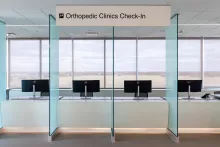Adolescent Hip Dysplasia
- For all other requests:
- 1-800-777-8442
Hip pain can occur at any age. But when it affects children, adolescents, or young adults, it may be a sign of a joint problem called hip dysplasia.
Adolescents and young adults who have persistent, severe hip pain should consider seeing a hip specialist. If left untreated, hip dysplasia can cause cartilage damage, early osteoarthritis, or a dislocated hip.
Currently, the osteotomy procedure most commonly used to treat adolescent hip dysplasia is a periacetabular osteotomy (PAO). In conjunction with PAO, your doctor may recommend hip arthroscopy to repair a torn labrum.
Fortunately, orthopedic experts from University of Iowa Health Care frequently treat this condition. We have a unique clinic that specializes in hip problems among teens and young adults. Performing hundreds of these surgeries each year, we’re the only medical center in Iowa that offers combined surgery for periacetabular osteotomy and hip arthroscopy to get you back to the life you love more quickly.
Hip dysplasia symptoms and diagnosis
The hip is a ball and socket joint. The top of your thigh bone has a rounded shape, like a ball. Normally, it fits into a bowl-shaped depression (socket) in your pelvis.
With hip dysplasia, the socket is too shallow, meaning the ball doesn’t fit snugly inside the socket. This limits movement and causes the joint to wear out faster than it should. It also damages the special tissues (cartilage and labrum) that lines and cushions the joint.
Hip dysplasia is often congenital (present at birth). It can also develop as your bones grow through childhood and adolescence. In either case, you may not have symptoms until you reach adulthood.
Hip dysplasia symptoms
Most people with hip dysplasia develop one or more of the following symptoms:
A feeling of looseness or instability in the joint
A popping or “catching” sensation that occurs with movement
Hip or groin pain that gets worse with activity (especially standing, walking, or running)
Limping while walking
Stiffness or reduced range of motion in the hip
Uneven leg lengths (one leg is longer than the other)
Hip dysplasia diagnosis
If you have symptoms of hip dysplasia, call UI Health Care. Our orthopedic specialists are skilled at distinguishing hip dysplasia from other conditions that cause hip pain (such as hip impingement and iliotibial band syndrome).
We usually diagnose hip dysplasia with one or more of the following tests:
A physical exam to evaluate your hip structure, stability, and flexibility.
A diagnostic hip injection that uses medicine to numb the joint. If your pain goes away after the injection, then the source of the pain is probably within the hip.
Imaging tests such as an X-ray or MRI scan. These help us confirm whether there is a structural abnormality and cartilage damage.
Hip dysplasia treatment from UI Health Care
The pain caused by hip dysplasia can be severe, but you don’t have to live with it. The sooner we diagnose and treat hip dysplasia, the sooner you can get back to your regular activities.
Nonsurgical treatments for hip dysplasia
Some people with mild hip dysplasia can reduce their symptoms—and slow or prevent additional joint damage—with nonsurgical therapies. These include:
You may be able to remove extra pressure (and subsequent pain) from your hip by making certain lifestyle modifications. For example, you should avoid activities that trigger your hip pain and try lower-impact exercises like swimming. You may also find relief by maintaining a healthy weight.
Anti-inflammatory medicines (like ibuprofen) and injectable steroid medicines can reduce hip pain and inflammation.
Our physical therapists can teach you exercises to improve your hip strength, flexibility, and range of motion. We can also help you strengthen nearby muscle groups, which creates extra hip support.
Hip dysplasia surgery
If nonsurgical treatments don’t help, or your hip dysplasia has caused cartilage damage, your provider may recommend surgery.
If you’re in your 20s or 30s—or you have a teen with hip dysplasia—having surgery can help you stay active. It can also help you avoid (or delay the need for) a hip replacement later in life.
With hip dysplasia surgery, we often have two goals:
-
Realigning the joint: During an open procedure called periacetabular osteotomy (PAO surgery), your surgeon cuts into your pelvis. They’ll free the socket from its original position and move it higher or lower. This allows the rounded head (ball) of your thigh bone to fit better inside. If necessary, they’ll also reshape the ball (femur osteotomy).
-
Repairing cartilage: Many people with hip dysplasia develop a cartilage injury called a torn labrum. If you also need cartilage repair, which uses a minimally invasive technique called hip arthroscopy, we’ll take care of it at the same time as your PAO surgery.
In older adults—or in cases where hip dysplasia has already progressed to osteoarthritis—we may need to perform hip replacement surgery instead of PAO surgery.
No matter which approach we use, you can feel confident in our team. As a regional referral center for hip dysplasia, we treat people from several nearby states. In fact, we perform more than 300 hip dysplasia surgeries every year.
People with hip dysplasia are prone to other hip problems. To that end, our hip dysplasia specialists often partner with other hip experts. These include providers who specialize in:
-
Hip preservation
-
Hip arthroscopy
-
Hip impingement
-
Labral tear
-
Pediatric hip dysplasia
Our Care Team







- Orthopedics and Rehabilitation


Looking for hip dysplasia treatment?
Locations and Offices



Patient Stories

